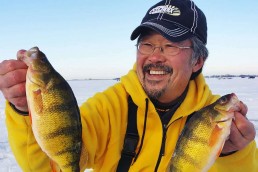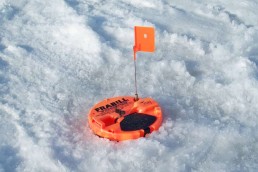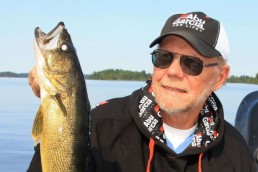Get After Early-ice Walleyes
SHARE THIS POST
It’s been said that any time is a good time to go walleye fishing. And although I thoroughly agree with that statement, there are certainly times more apt to eating. It’s always good for the soul to spend time on the water, but of course it’s better to come home with a few extra smiles and some walleyes. Early ice is definitely one of these special times. Walleyes haven’t been pressured much leading up to it and they are generally in the mood to eat. This opens up a window throughout the Midwest that is golden, much like the hue that adorns them.
Be sure to do a little homework before the next trip and bring along a few options so you can be better prepared once on the ice. There are always a few tips that can help make it happen—pay attention to those details to ensure success this ice season:
Match the hatch
If you want to consistently taste that success it pays to be cognizant of the food sources present in the system. Current lake information can also be key. If the water is murky for whatever reason one year versus the next, then brighter colors with rattles may attract more fish and bites. Or, perhaps it’s clearer this year than the past and you need to downsize and go with more natural color patterns.
A nearby lake used to be chock full of smelt. This baitfish would grow to 5 inches and even longer. So bigger, silver jigging spoons would work fantastic come the magic hour. One summer then, the smelt got pinched in between the oxygen and water temperature dilemma and lost out, as the majority of the smelt died. The major food source disappeared and consequently the baits that closely matched that forage started to lose their luster over time. Sometimes it’s hard for anglers to change from what used to work.
Fast-forward to a few years: The lake is full of little perch. So, guess what bait color produces well? Perch colors. And not just a little bit—a lot. These waters went from having a lot of walleyes “looking at the bait” and moving on, to fish not even having to think about the bait in front of them—they just hit it. Smaller-sized Macho Minnows in perch color were lights-out all winter. When the fish are used to forage, it’s a lot easier to entice a bite when it closely matches it.
Are you enjoying this post?
You can be among the first to get the latest info on where to go, what to use and how to use it!
Get the gear
Make sure to bring along your electronics and GPS to easily find the spots and the water column. Invest in a quality rod that will allow you to feel strikes and get a solid hook-set. Fluorocarbon line has great abrasion resistance and also allows you to feel bites better. In walleye fishing, you don’t get hundreds of bites, so you need to make the ones you get count. The 5-pound-test Sufix fluorocarbon has been my go-to line for the last few years. It allows plenty of strength to get big ones up and increases the sensitivity over the conventional monofilament. When it’s cold it’s tough for your hands to feel a subtle strike from an “eater” walleye. Using the right setup will put the odds in your favor.
Timing is everything
Walleyes have great low-light vision. In fact, it is superior to most species that swim. This is why they forage mostly around low-light conditions because it increases their chance of success. Simply put, that is the best time to fish them. Mornings, evenings and even overcast days will give you an advantage of timing the “magic hours” when they are most actively feeding.
It is so important to go sooner than later; don’t miss the bite as it generally slows down as the ice season presses on, particularly on smaller bodies of water. You don’t have to be crazy, but you do have to be safe. Bring along some company, test the ice frequently and go on foot until there is enough ice to support other means of travel.
Pick your high-percentage spots, like humps and points for early ice and cash in on the opportunity.
MWO
SHARE THIS POST
Did you enjoy this post?
You can be among the first to get the latest info on where to go, what to use and how to use it!
Steve Mattson
Steve Mattson has been writing articles for MidWest Outdoors since 2001. He is a driven angler, guide and sponsored tournament pro who has won both bass and panfish tournaments, and has placed in walleye and pike events. He resides in northern Minnesota and enjoys helping others catch more fish. For more info: mattsonangling.com and @mattsonangling.




